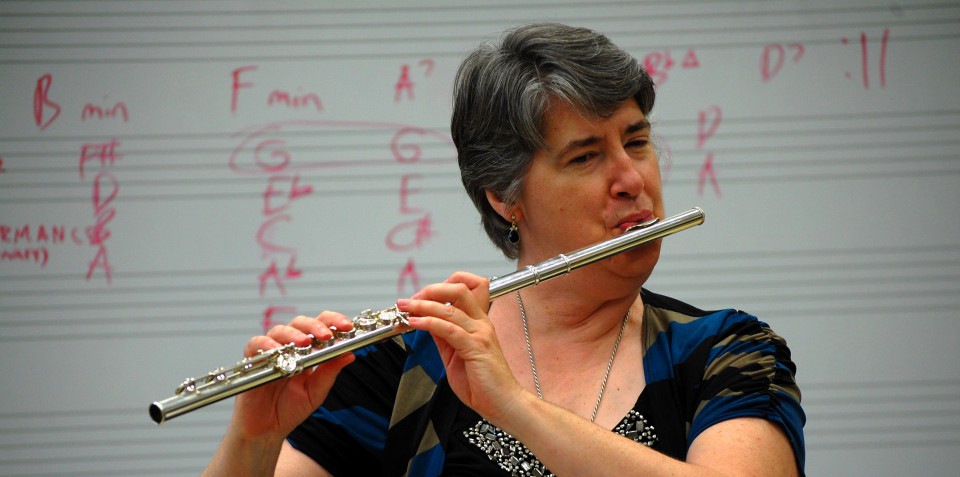Your flute students (and other woodwinds) are usually going to be asked to trill by the time they have been playing a year or so. Trills provide the flutes and other woodwinds the opportunity to add brilliance and excitement to a score. Forgive me for stating the obvious, but a trill is a rapid alternation between adjacent pitches, up either a half step or whole step from the notated pitch (never down). The next question is how does one know whether it’s a whole or half step? One word answer – context. Here are the basic rules for trilling:
- Trill to the next note above the notated pitch in the key except….
- If there is an accidental next to the tr sign, then trill to the accidental indicated or….
- If the note being trilled is itself an accidental, again trill to the next note in the notated key unless there is an accidental next to the tr, as previously noted.
- Anything bigger than a whole step is considered a tremolo, not a trill.
In the absence of direction, kids will come up with the darnedest things, especially in the case of trills. They know they need to wiggle something, so they do….any adjacent finger will do. Doesn’t matter if it is up or down. They think because they are wiggling a finger, they are trilling. And it sounds just awful.
Here are some pointers about trill fingerings. Many trill fingerings are obvious like F to G, G to A. No special fingering chart needed. However, a large proportion of trill fingerings are not “normal” fingerings. Trill fingerings are a collection of cheats, hacks and other tricks you would never use to play a regular note. They idea is we are trying to simplify the fingerings to be able to wiggle as few fingers as possible, with only one finger being ideal (but not always achievable). The alternation is rapid enough that the listener won’t hear it’s a cheater fingering. Some notable examples include C to D (first trill key), Db to Eb (second trill key), E to F# (finger E and wiggle the right first finger). Trills that include Bb almost always require using the thumb Bb. Third octave trills require using harmonic fingerings. Having a good trill chart is not just a good idea, it is essential. I recommend the Woodwind Fingering Guide (It’s available on the web. You can see it on your phone in your pocket. No excuses.)
One small performance practice caveat regarding trills in music written before 1800. It is considered correct to start the trill on the auxiliary pitch rather than the notated pitch (except when approached from the scale degree directly above the notated pitch). If you are interested and have time, check out the Quantz treatise, On Playing the Flute. There’s an entire chapter on trills in the Classic, Pre-Classic and Baroque periods.
Lastly, for trills to sound good, you need to remember to blow. You can be furiously wiggling your finger, but without sufficient blowing, there’s no point. In this respect, trilling is like tonguing. It is very easy to get distracted by the wiggling finger or the tonguing and forget that the very foundation of flute playing (indeed any playing any wind instrument) is blowing, keeping the air column moving and energized.
If you find these entries useful, please subscribe, share with your colleagues and come back regularly for more flute tips. Feel free to comment. If you have a topic you would like to see explored more fully, you can contact me via IM/Messenger on Facebook or email me at dr_cate@sbcglobal.net. For information about clinics and workshops click here.


Pingback: The Top 10 Blog Posts of 2017 | Dr. Cate's Flute Tips
I had understood that in playing a trill in a Baroque piece (like Trumpet Tune, Trumpet Voluntary) one should start on the upper note and go down a half step to the dominant note.
LikeLike
You are correct that in Baroque music you start the trill from above, on the auxiliary note. However, the auxiliary note will be the next note higher in the key you are playing. It can be a whole step or half step above the principal note, depending which degree of the scale you are trilling. In the case of the Trumpet Voluntary, if you are trilling the D, the auxiliary note is E, a whole step above D. This is because the E is the next note higher than D in C major. An Eb would sound really bad since it’s not in the key of C major. So the correct trill in this case would be to start a D to E natural trill from E natural. In the Trumpet Voluntary, you would be trilling between the 2nd and 3rd degrees of the major scale, a whole step. The only likely places you might run into a half step trill in Baroque music would be between the 3rd and 4th degree of the scale or between the 7th and the tonic.
LikeLike